The Nexus 7 (2013) Review
by Anand Lal Shimpi on August 22, 2013 6:00 PM EST
Truth be told, Google has made (or at least directed the making of) some of the best tablets on the market today. The original Nexus 7 was groundbreaking in that it offered a totally usable platform, married to the latest version of Android, for $199. The Nexus 10 gave us a very quick, ultra high resolution 10-inch tablet for $100 less than the flagship iPad (and with more storage). Both were easily recommendable due to their value, but this year Google is stepping out of the shadow of value and into one of excellence. It starts with the new Nexus 7.
Based on the success of the original Nexus 7, Google went back to ASUS for the second version. In the 12 months since the release of the Nexus 7, the world has changed quite a bit. Expectations for value tablets had been reset by the original Nexus 7 as well as Amazon's lineup of Kindle Fires. Simply showing up with another good value likely wouldn't do anything to further the brand (or market). I get the distinct impression that Google isn't big on not changing the world.
| Nexus 7 Tablet Specification Comparison | ||||
| ASUS Nexus 7 (2012) | ASUS Nexus 7 (2013) | |||
| Dimensions | 198.5 x 120 x 10.45mm | 200 x 114 x 8.65mm | ||
| Chassis | Plastic + Rubber back | Plastic + Soft Touch back | ||
| Display | 7-inch 1280x800 IPS | 7.02-inch 1920x1200 IPS | ||
| Weight | 340 g | 290 grams (WiFi), 299 grams (LTE) | ||
| Processor | 1.3 GHz NVIDIA Tegra 3 (T30L - 4 x Cortex A9) | 1.5 GHz Qualcomm Snapdragon S4 Pro (APQ8064-1AA) | ||
| Memory | 1 GB | 2 GB DDR3L | ||
| Storage | 8 GB / 16 GB | 16 GB / 32 GB | ||
| Battery | 16 Whr | 15.01 Whr | ||
| WiFi/Connectivity | 802.11b/g/n, BT, NFC | 802.11a/b/g/n, BT 4.0, NFC | ||
| Camera | 1.2MP Front Facing |
5.0 MP Rear Facing w/AF 1.2MP Front Facing |
||
| Wireless Charging | – | Yes (Qi Compatible) | ||
| Pricing | $199/$249 |
$229/$269 (WiFi 16/32 GB) $349 (LTE) |
||
The result is the new Nexus 7. Identical only in name, manufacturer and screen size, the 2013 Nexus 7 is a downright Apple way to rev a product. Google made it thinner, lighter, faster and better in almost every way.

2013 Nexus 7 (left) vs. 2012 Nexus 7 (right)
The original Nexus 7 was rather thick but it got away with it since the overall footprint of the tablet was so small. The new Nexus 7 truly feels like a slate. It's the type of thing I expect to see carried around on the Enterprise.
I don't miss the rubber imitation leather from the original Nexus 7, it's replaced by a soft touch plastic back. You definitely don't get the premium aluminum feel of the iPad mini, but the device doesn't feel cheap either. The new Nexus 7 is still nice enough that I'm nervous about scratching or scuffing the back.
Both ASUS and Nexus logos are prominently featured on the back. ASUS continues to amaze me by just how far it's come as a company, and the new Nexus 7 is hands down its most impressive tablet creation yet. From a build quality standpoint I really have no complaints about the Nexus 7. While the MeMO Pad HD7 has some creaks and flex in the chassis, the new Nexus 7 feels like a solid slab of soft plastic and glass. It's nice.
Unlike the original Nexus 7, the new model features stereo speakers on back of the tablet. It's an easy feature to take for granted but going back to the old mono design sounds worse.
I agree with Brian that the power/lock and volume buttons are the only real sore spot on the physical execution. They aren't particularly well defined and feel a bit mushy. Even writing this paragraph feels like I'm nit picking though, the build here is really good.
The only other complaint I'd levy against the new Nexus 7 is that the design doesn't particularly stand out as being unique. The iPad has its aluminum, the Moto X has its wood, but the Nexus 7 falls victim to the fact that ultimately it's tough to make these ultra mobile devices stand out. You need a large glass surface and you need a back. Black also tends to be one of the easier colors to sell (get too creative and you end up with inventory problems). It's not a huge deal to me personally, but as mobile devices can often be fashion statements I don't know that the new Nexus 7 has all that much curb appeal.
The Display
What the Nexus 7 lacks in pizazz, it completely makes up for once you power on the display. The 7-inch 1920 x 1200 display produces colors that are not only vibrant but, for the first time ever in a Nexus device, accurate as well. Google really worked on color accuracy this time, with a two step calibration process - once at a high level by the panel maker and once again per device during final manufacturing. The result is just awesome:
The Nexus 7 display is not only visually appealing but stacks up incredibly well in our CalMAN display tests. Although it loses to the iPad 4, the Nexus 7 gets indiscernibly close in many cases and blows the non-Retina iPad mini out of the water. I won't even bother comparing it to everything else in the Android space, they don't hold a candle to it.
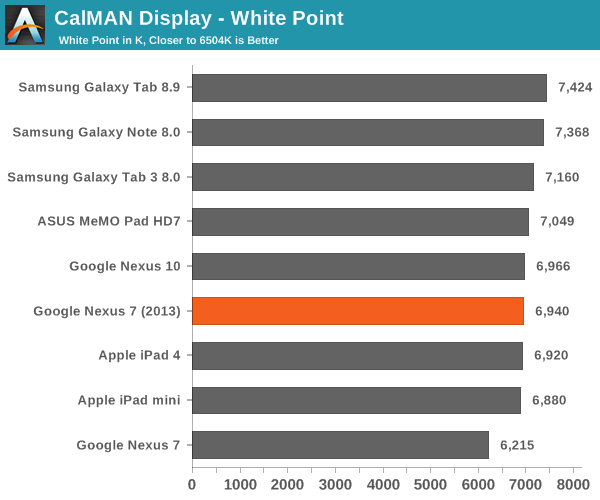
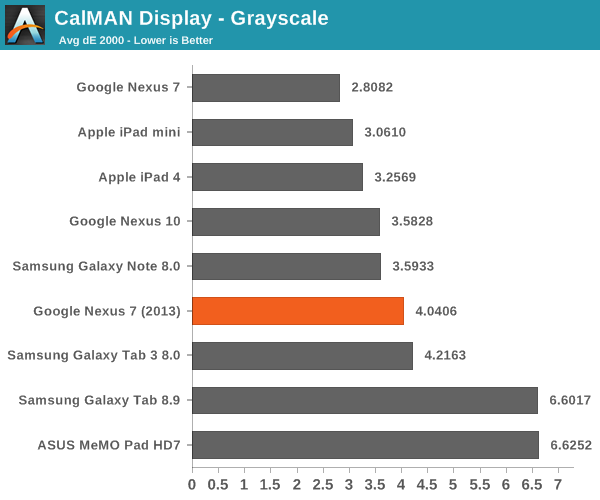
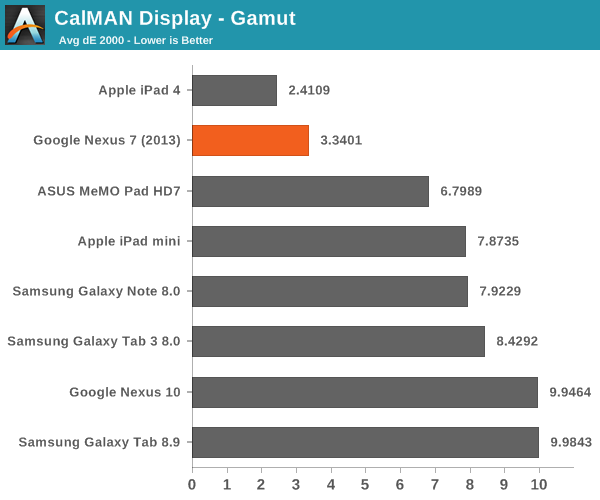
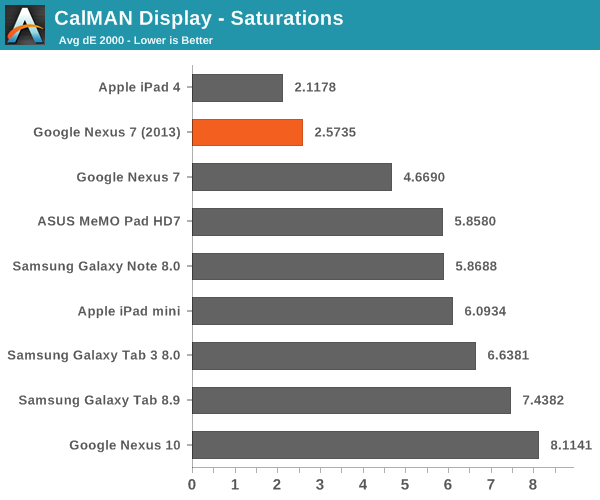
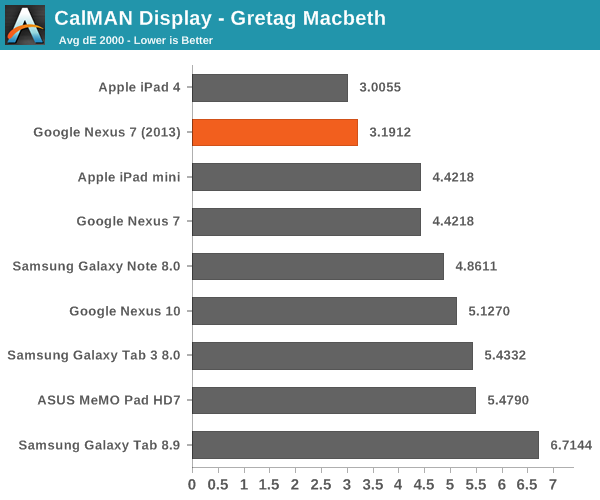
The new panel is also incredibly bright. I typically view 500 nits as the threshold for outdoor usability, and the new Nexus 7 definitely exceeds that threshold. The tablet will drink away all of your battery life if you leave it at this brightness setting indefinitely, but if you need to actually use your tablet outdoors for a while the Nexus 7 works.

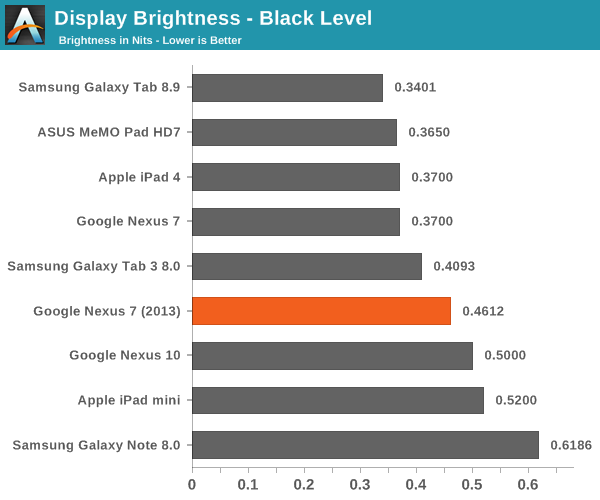
Black levels are a bit higher than on the original Nexus 7, but the resulting peak contrast ratio is still excellent:
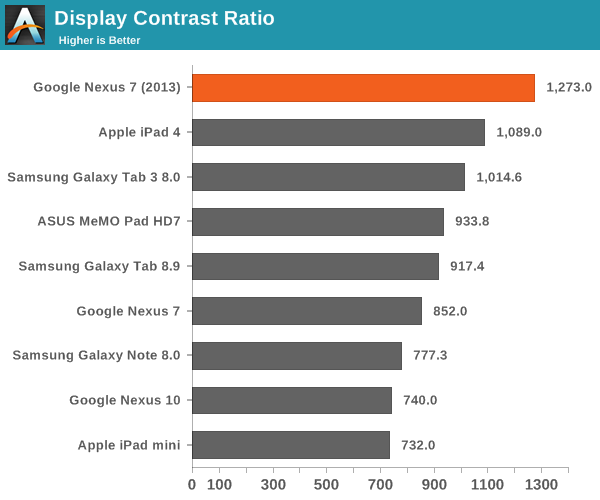
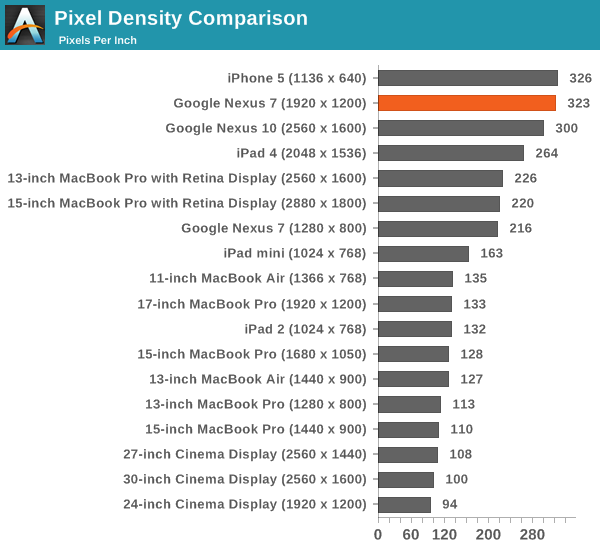
Pixel density shoots through the roof with the new Nexus 7 display as well. Brian was quick to point out that a major advantage of the Android platform is in its flexible resolution handling. The 1920 x 1200 panel presents itself as a 960 x 600 panel to web pages in Chrome, while other apps can use every last pixel for unique content (e.g. games).
The beauty of not having to double the original Nexus 7's resolution but instead settling on an in-between option like 1920 x 1200 is that Google could get away with a performance mainstream SoC instead of something ridiculously high-end.
The display looks great when viewing everything from photos and movies to web pages and eBooks. My only complaint about the Nexus 7's display is its size. A 7-inch tablet is almost pocketable (in fact I did carry it around in my pocket for a day), but the screen can feel a little cramped.


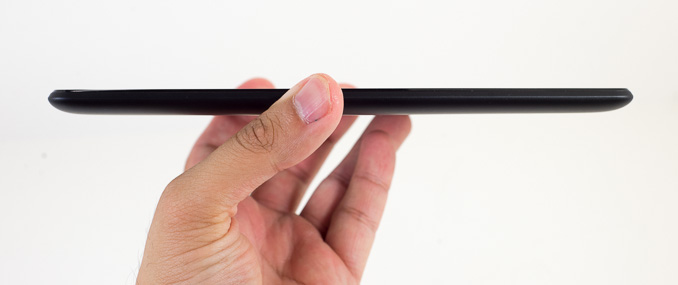
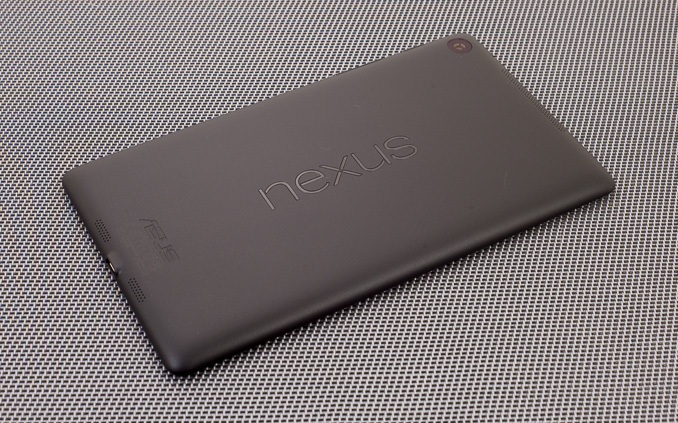
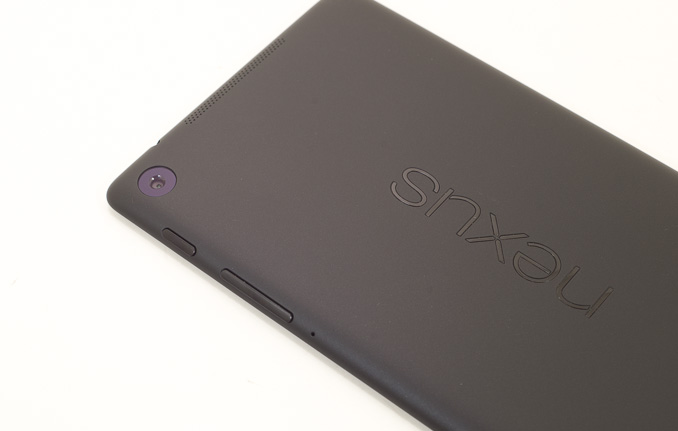


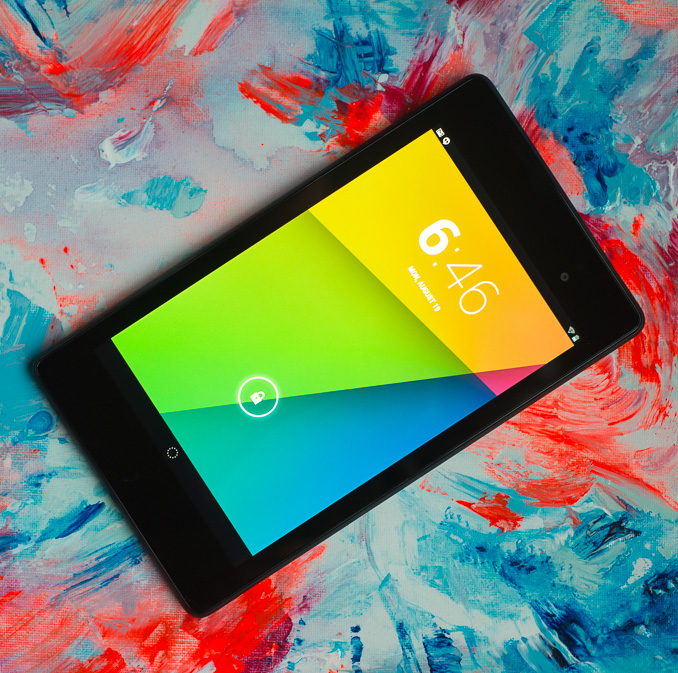
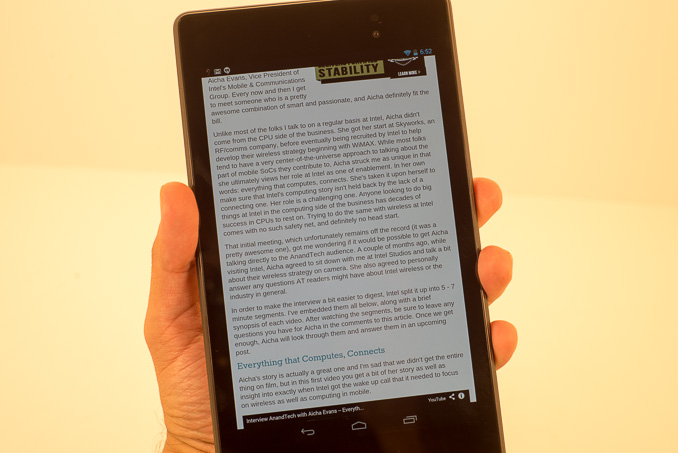
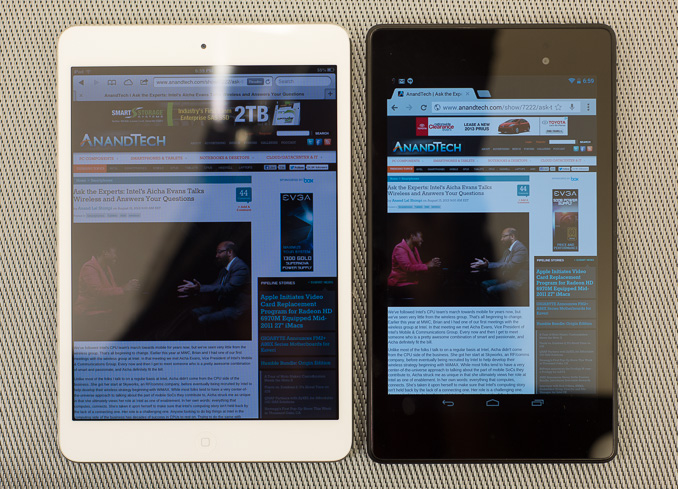








202 Comments
View All Comments
darwinosx - Thursday, August 22, 2013 - link
I'll review it. It's a piece of junk with poor quality build, a washed out screen, and a really slow gpu. The iPad 4 blows the doors off it. Hows that?smartypnt4 - Thursday, August 22, 2013 - link
You're an incredibly negative individual, do you know that? Everyone knows the iPad 4 is better than the N10. That's never really been a debate. The N10 also costs $100 less, so there's that.I agree with your essential assessment, though. In essence, it had build quality issues, and a dreadful screen in comparison to the N7 and the iPad 3/4. Colors were washed out, it was incredibly dim, lacked contrast, etc. The really slow GPU thing I can't really attest to, although benchmarks indicate it's not *horribly* slow, especially for something that came out last year. Yes, it's slower than the iPad 4. Basically, anything released within ~6 months of an iPad historically can't match the GPU power. Comparing it to the Android space, it was relatively quick last year. Not so much now, though.
I do agree with you, though. Proof: when my N10 was stolen, I replaced it with an iPad 4.
Midwayman - Friday, August 23, 2013 - link
Anything from 2012 with a full HD screen or higher running Android was underspec'd anyways. They hadn't upped the hardware to deal with the demands of the higher res screens yet. 2013 is looking to be a different matter.smartypnt4 - Sunday, August 25, 2013 - link
After owning and using the N10 at launch last year, I can say that I never felt that the GPU held it back in the OS. The transitions were all very smooth throughout the OS. Some apps behaved weirdly, but that was because they rendered to a fixed size, which looks comical on a tablet with a pixel density that high. There were plenty of other things that were off about the N10, though. Supposedly ASUS got the nod for this year's Nexus 10, so I'm looking forward to their take on it.jl0329 - Wednesday, October 9, 2013 - link
Go home, time to change your diaper you little brat.Krysto - Thursday, August 22, 2013 - link
I agree they should move to 8" next year, or at least 7.7", and no more than a width of five inches, because then it becomes too wide (the iPad Mini is too wide for one-hand use).But yeah I'd prefer it was a bit bigger to justify getting one when you already have a big smartphone.
sherlockwing - Thursday, August 22, 2013 - link
Don't know about you, but I bought a N7 2013 when I already have a GS4(5") and the Media viewing expewrience on the Nexus 7 is substantially better. The N7's display(22.02 in^2) is twice as large as GS4's(10.68 in^2), and 85% more space when viewing 16:9 content( 19.8 vs 10.68). I find it perfectly justifiable to buy even if I have a GS4.Now if your defination for "big smartphone" is a Note then I see your point. It won't take too much effort to get a 7.5" screen on N7 if the bezel is reduced to Ipad Mini level. The screen/front area ratio of N7 is only 62%, Ipad mini's is 71.8%.
CSMR - Thursday, August 22, 2013 - link
"802.11ac is probably the only thing missing from this otherwise awesome platform"802.11ac will take years to start being used, and decades before it makes earlier wifi standards obsolete. In the life of a current device, there will be no occasions when 802.11ac will be available and providing internet but other wifi standards are not.
Lack of cellular connectivity on the other hand results in lack of internet access in most locations, and is a major omission.
solipsism - Thursday, August 22, 2013 - link
If you're defining it as not being used anywhere by anyone in favour of a new standard, then I guess I agree it will take decades. But by that notion there are people still using floppy disks.If you wish to be less draconian with your definition then your decades claim doesn't hold water. Including 802.11b in a device that supports 802.11g/n as a back up that is inexpensive for the component vendor to include doesn't mean it's being utilized extensively.
Also note is was only a decade between the 802.11b and n standards and 802.11n took off faster (for various reasons) than 802.11b so I can't see how it will be at least 2x longer before it gains a foothold, especially considering the focus society has for WiFi and excellent job the committee did in ratifying ac compared to n.
Finally, "there will be no occasions when 802.11ac will be available" and "802.11ac will take years to start being used" are just outright wrong. I use 802.11ac every single day. It's available! You can buy routers and devices that use this standard and they aren't priced at levels that make it unreasonable to obtain.
CSMR - Friday, August 23, 2013 - link
I was not saying it will take decades for people to start using 802.11ac. What will take decades is for them to switch off 802.11g and 802.11n. You may use 802.11ac now and good for you, but you can still get an internet connection with 802.11g/n. The main advertised advantage of 802.11ac is speed, but it will at least 10 years until typical internet connections saturate an 802.11g link let alone 802.11n.I am not against putting 802.11ac in devices as soon as it becomes a standard integrated part of modern chipsets, but the point is always-on internet is important, and if you do not have cellular connectivity then you will lack internet whenever you are outside your wifi network.